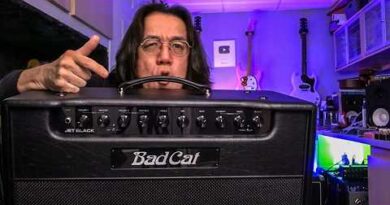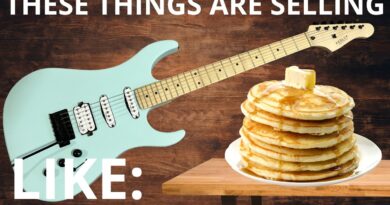Electric guitar body TONEWOOD – Myth or Fact? Judge for yourself here!
The type of wood of an acoustic instrument has a huge influence on tone, but what about electric guitars? This is sometimes referred to as the Tone Wood Debate. In the guitar community there is no clear consensus on this issue. In this video the exact same guitar neck, pickup and hardware are assembled to two bodies of identical dimensions and density. One is Mahogany and one is Maple.
Also a third body made of Pressure treated Fir, from Friday’s clip, is included in the comparison, that one has different dimensions and density though.
Amp setup: 1977 Marshall Super Bass into 2x 1971 Marshall 1960A and 1960B 4×12 Cabs, miked by Unidyne IV 548 close mic and AKG C414 BXLII room mic.
Dimensions Maple and Mahogany bodies: 510x120x21mm, density for both 650 g/m3
Dimension Pressure treated Fir: 415x120x27, density 920 g/m3
#Electric #guitar #body #TONEWOOD #Myth #Fact #Judge
Originally posted by UCyaStghQb7_e51PgH8bUkzg at https://www.youtube.com/watch?v=nrEar7dgVwI




Differences between guitar body materials are miniscule (comparing with tone pots – or lack of them, parameters of the pick, strength of the signal and complexity of the rig and the pedalboard). They are easy to eliminate via EQ. And virtually non-existent in high gain styles of guitar playing.
If anything, we can have a flame war about speakers and mics – which are those things that actually have something to do with the air vibrations reaching our ears. (With modelers and fully electronic process of recording maybe monitors or earphones are legitimate points of interest, too).
Plus, trolling the cult of tone wood superstition is a service to humanity.
Plus, all hail Jim Lill!
I'd always thought Epiphone made glued necks, rather than bolted on.
????????????
u know what the call the Swedish chef in Sweden?
this is so awkward in 2024 after all this got scientifically debunked haha
Безсмысленный эксперимент сравнивать доски разной длины (массы)
All the riffs were played differently. Not an accurate test
I wonder why you chose such small blocks of wood? One would think that using a realistic amount of wood would increase the influence (if any) of wood vs other components or factors..
TLDR, compared with hard maple:
Douglas fir: slightly stiffer, 3/4 the weight of it, less than half as hard.
Mahogany: 4/5 as stiff, almost the same weight, but half as hard.
Hard maple: About the same as hard maple
Boring technicals:
Hard maple: 12.6 GPa stiffness (MOE), 705 kg/m3 density, 6.45 kN janka hardness
Douglas fir: 13.4 GPa stiffness (MOE), 530 kg/m3 density, 2.94 kN janka hardness
Mahogany: 10.0 GPa stiffness (MOE), 650 kg/m3 density, 3.56 kN janka hardness
You didn't take into account what altitude each tree grew at and what the alkaline content of the soil was.
I think there is a good argument to be made as to how people pick a guitar differently when holding a guitar that weighs differently. A light guitar you might hold up more with your non-picking hand, even if you're trying very hard to be consistent. If someone built a strumming machine to pair with a wood test and did repeated experiments, it would solve the issue a lot more conclusively.
Mahogany does have a pronounced low and softer at highs. Sounds a bit "thicker" relatively.
you're not even playing the same riffs correctly, do open tuning or lapsteel, no wonder no one dares to respond, there is no such thing as difference. Maybe in an acoustic setting, not in an electric setting.
Woah that’s a thick accent. It’s like, you’re speaking swedish, it’s just that the words you’re using are english.
I'm late here…just found this video. It was quite interesting, I could hear subtle differences while watching the video, but then I did an experiment, blindly listened to see if I could tell when you switched from one wood to another. I couldn't tell. I think that often we have outside influences that confirm our biases in this case the visuals. Acoustically, definitely wood affects tone. Electric? I'm not sold either way yet. If there is a difference it is so subtle that for practical purposes on stage with other band members playing live it wouldn't really matter. That said, in all of these tonewood comparison videos, I've never seen one that tests whether wood affects sustain. In theory I think that is where the real difference would manifest itself. Granted, I haven't actually searched for a video that tests that. Maybe there are some out there. Ok, here I come google…
you can think of the plank of wood as one prong of a pitch fork—such a simple shape will have a natural resonance frequency to it. And the wood type will affect this Freq.
Might be a more valid test if the lumps of wood were guitar shaped instead of those tiny bits of wood. Might have more chance of hearing if any body resonance is affecting the string resonance.
I think the word is 'timbre' not tone…
But glen fricker yelled at me and told me wood doesn't make a difference in sound. I think that not hearing it is a side effect of using a metal zone for too long.
I Want This Guitar so Badly:D hoping for Signature Versions !
!
Nice Video!
Mahogany is the best Wood: +Sustain, +mids and bass.
These videos are the reason the tone wood hoax is still going????
it is the visual color of the wood the one who makes people associate a sound color with visual color characteristics. there are differences, and if you put your axe in direct contact with your ear, you can notice a few of them. since you filter that frequencies with pickups, amps and effects, most of those differences disappear and the rest become completely impossible to perceive.
My guitar is a neck thru solid black walnut. People don’t even know what they’re missing out on. Alder and basswood make for nice guitars but for the $ you might as well get heavier wood.
We need an ociliscope????
Interesting! My ear liked the detail in the maple the best.
Acoustically? Big differences.
Electronically? Hah. No..
mesma porra!
this is a good IQ test, if you believe any of this….. Im sorry but you are on the wrong side of the average…..
You changed your hand position every time when doing each riff, thst heavily affects the sound. Did you measure the distance between the strings and pickup for each test, and put the pickups in precisely the same place every time?
Where are you from?
They all sound the exact same. your picking is also not controlled enough to make a sound comparison.
Unless you put it through test gear, this test means nothing. People are going to hear what they want. I personally don't believe any arguments that suggest wood makes a difference in the tone in an electric guitar. Show me, WITH TEST EQUIPMENT! Prove it with blind test and test equipment.